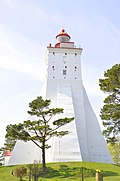 | |
 | |
| Location | Pakri Peninsula, Harju County, Estonia |
|---|---|
| Coordinates | 59°23′15″N 24°02′16″E / 59.38740255°N 24.0377221°E |
| Tower | |
| Constructed | 1724 (first) 1760 (second) 1808 (third) 1889 (current) |
| Construction | brick |
| Automated | 1996 |
| Height | 52 metres (171 ft) |
| Shape | cylindrical tower with balcony and lantern |
| Markings | red tower and black lantern |
| Heritage | architectural monument |
| Light | |
| First lit | 1889 |
| Focal height | 73 metres (240 ft) |
| Lens | hyperradiant Fresnel lens |
| Range | 12 nautical miles (22 km; 14 mi) |
| Characteristic | LFl W 15 s. |
| Estonia no. | EVA 380[1] |
 | |
Pakri Lighthouse (Estonian: Pakri tuletorn) is a lighthouse located on the Pakri Peninsula (on the coast of the Baltic Sea), Harju County, in Estonia.[2]
History
[edit]The first known lighthouse to be built on the Pakri Peninsula was in 1724. The location of the lighthouse was allegedly picked by Tsar Peter the Great.[3] In the year of 1889, the current lighthouse, made out of limestone, was built 80 metres away from the old one. The Pakri old lighthouse was partially demolished, and used as a paraffin store. The lighthouse and lighthouse keeper's house were severely damaged during World War II; however, these structures have survived, and in 2001 the lighthouse was fully renovated.[4]
See also
[edit]References
[edit]- ^ Rowlett, Russ. "Lighthouses of Northern Estonia". The Lighthouse Directory. University of North Carolina at Chapel Hill. Retrieved 24 November 2015.
- ^ "Pakri Lighthouse Details". Navigatsioonimärgi. Archived from the original on 27 September 2015. Retrieved 26 September 2015.
- ^ "Stamps". Eesti Post. Archived from the original on 27 September 2015. Retrieved 26 September 2015.
- ^ "Pakri Lighthouse". Estonian Lighthouse Society. Archived from the original on 3 October 2015. Retrieved 26 September 2015.
External links
[edit]- "Navigatsioonimärgi 380, Pakri tuletorn andmed". Navigatsioonimärkide andmekogu (in Estonian). 9 December 2018. Archived from the original on 9 December 2018. Retrieved 7 May 2019.

Well, that’s interesting to know that Psilotum nudum are known as whisk ferns. Psilotum nudum is the commoner species of the two. While the P. flaccidum is a rare species and is found in the tropical islands. Both the species are usually epiphytic in habit and grow upon tree ferns. These species may also be terrestrial and grow in humus or in the crevices of the rocks.
View the detailed Guide of Psilotum nudum: Detailed Study Of Psilotum Nudum (Whisk Fern), Classification, Anatomy, Reproduction